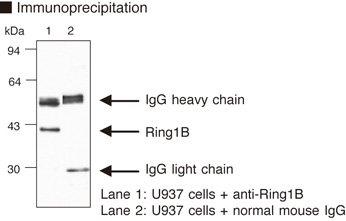| Data |
 Immunoprecipitation Immunoprecipitation

|
| Clonality |
Monoclonal
|
Clone |
3-3 |
|
Isotype
(Immunized Animal)
|
Mouse IgG2b
|
| Applications |
- WB
- 1 µg/mL
 - IP
- 1-5 µg/200-300 µL of cell extract
 - IH*
- reported. (PMID: 20351251)
 - IF*
- reported. (PMID: 24055057)
 - ChIP*
- reported. (PMID: 20473294 / 21170310)

|
| Immunogen
(Antigen) |
Recombinant Mouse full length Ring1B
|
| Reactivity
[Gene ID] |
Human[6045], Mouse[19821], Hamster |
| Storage buffer |
1 mg/mL in PBS/50% glycerol, pH 7.2
|
| Storage temp. |
-20°C
|
Conjugate |
Unlabeled |
Manufacturer |
MBL |
| Alternative names |
Rnf2/ring finger protein 2, BAP1, DING, BAP-1, HIPI3, RING1B/dinG
|
| Background |
Polycomb-group (PcG) proteins form multimeric complexes that maintain the state of transcriptional repression of several regulatory genes during development. Ring1B/Rnf2 forms part of a protein complex containing other PcG proteins, such as Mel18, Bmi1, MBLR, MPc3, and the spliceosome protein Sap155, and these complexes associate with chromatin to regulate transcription. Ring1B may also play a role in the regulation of Hox gene expression by PcG complexes. Deletion of Ring1B activity results in gastrulation arrest and cell cycle inhibition. |
| Related products |
D138-3 Anti-Sap155 mAb
D221-3 Anti-Sap155 mAb
D210-3 Anti-Histone H2A mAb
|
| Citations |
Western Blotting - Sarcinella E et al. Monoubiquitylation of H2A.Z distinguishes its association with euchromatin or facultative heterochromatin. Mol Cell Biol. 27, 6457-68 (2007)(PMID:17636032)
- Wu X et al. Cooperation between EZH2, NSPc1-mediated histone H2A ubiquitination and Dnmt1 in HOX gene silencing. Nucleic Acid Res. 36, 3590-9 (2008)(PMID:18460542)
- Wu J et al. Histone ubiquitination associates with BRCA1-dependent DNA damage response. Mol Cell Biol. 29, 849-60 (2009)(PMID:19015238)
- Alchanati I et al. The E3 ubiquitin-ligase Bmi1/Ring1A controls the proteasomal degradation of Top2alpha cleavage complex - a potentially new drug target. PLoS One 4, e8104 (2009)(PMID:19337376)
- Zaaroor-Regev D et al. Regulation of the polycomb protein Ring1B by self-ubiquitination or by E6-AP may have implications to the pathogenesis of Angelman syndrome. PNAS 107, 6788-93 (2010)(PMID:20351251)
- Pradeepa MM et al. Psip1/Ledgf p75 restrains Hox gene expression by recruiting both trithorax and polycomb group proteins. Nucleic Acids Res. 42, 9021-32 (2014)(PMID:25056311)
- Tatavosian R et al. Distinct Cellular Assembly Stoichiometry of Polycomb Complexes on Chromatin Revealed by Single-molecule Chromatin Immunoprecipitation Imaging. J Biol Chem. 290, 28038-54 (2015)(PMID:26381410)
- Arora M et al. RING1A and BMI1 bookmark active genes via ubiquitination of chromatin-associated proteins. Nucleic Acids Res. 44, 2136-44 (2016)(PMID:26578590)
ChIP - Landeira D et al. Jarid2 is a PRC2 component in embryonic stem cells required for multi-lineage differentiation and recruitment of PRC1 and RNA Polymerase II to developmental regulators. Nat Cell Biol. 12, 618-24 (2010)(PMID:20473294)
- Mendenhall EM et al. GC-rich sequence elements recruit PRC2 in mammalian ES cells. PLoS Genet. 6, e1001244 (2010)(PMID:21170310)
- Wu X et al. Cooperation between EZH2, NSPc1-mediated histone H2A ubiquitination and Dnmt1 in HOX gene silencing. Nucleic Acid Res. 36, 3590-9 (2008)(PMID:18460542)
- Barco R et al. The synovial sarcoma-associated SYT-SSX2 oncogene antagonizes the polycomb complex protein Bmi1. PLoS One 4, e5060 (2009)(PMID:19337376)
- Williamson I et al. Anterior-posterior differences in HoxD chromatin topology in limb development. Development 139, 3157-67 (2012)(PMID:22872084)
- Pradeepa MM et al. Psip1/Ledgf p75 restrains Hox gene expression by recruiting both trithorax and polycomb group proteins. Nucleic Acids Res. 42, 9021-32 (2014)(PMID:25056311)
- Vallot C et al. PRC2-independent chromatin compaction and transcriptional repression in cancer. Oncogene 34, 741-51 (2015)(PMID:24469045)
- Gao R et al. Bmi1 promotes erythroid development through regulating ribosome biogenesis. Stem Cells. 33, 925-38 (2015)(PMID:25385494)
- Tatavosian R et al. Distinct Cellular Assembly Stoichiometry of Polycomb Complexes on Chromatin Revealed by Single-molecule Chromatin Immunoprecipitation Imaging. J Biol Chem. 290, 28038-54 (2015)(PMID:26381410)
Immunoprecipitation - Barco R et al. The synovial sarcoma-associated SYT-SSX2 oncogene antagonizes the polycomb complex protein Bmi1. PLoS One 4, e5060 (2009)(PMID:19337376)
- Zaaroor-Regev D et al. Regulation of the polycomb protein Ring1B by self-ubiquitination or by E6-AP may have implications to the pathogenesis of Angelman syndrome. PNAS 107, 6788-93 (2010)(PMID:20351251)
- Si S et al. Loss of Pcgf5 Affects Global H2A Monoubiquitination but Not the Function of Hematopoietic Stem and Progenitor Cells. PLoS One. 11, e0154561 (2016)(PMID:27136092)
Immunohistochemistry - Zaaroor-Regev D et al. Regulation of the polycomb protein Ring1B by self-ubiquitination or by E6-AP may have implications to the pathogenesis of Angelman syndrome. PNAS 107, 6788-93 (2010)(PMID:20351251)
Immunofluorescence - Casanova M et al. Heterochromatin reorganization during early mouse development requires a single-stranded noncoding transcript. Cell Rep. 4, 1156-67 (2013)(PMID:24055057)
|
| Product category |
- Research area
- Epigenetics
Cancer
|












 Citations
Citations Data Sheet
Data Sheet


